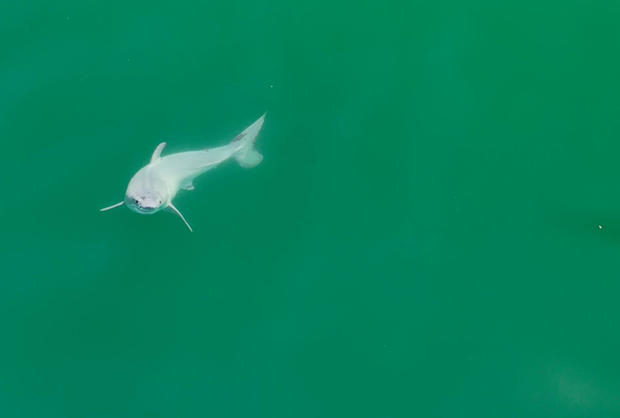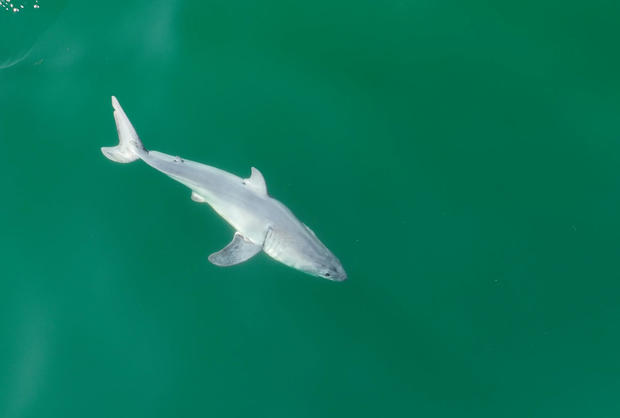These images may provide the world's first look at a live newborn great white shark
Great white sharks are among the most notable of the ocean's apex predators, but a crucial part of their existence has never before been recorded, or even seen – until now. For the first time, an infant great white shark is believed to have been caught on camera, shortly after it was born.
For years, wildlife photographer and videographer Carlos Gauna has ventured out to spend hours filming sharks, a process that he calls seeking to uncover "the secret lives of sharks."
"I want to kind of tell the story of what sharks do when we aren't watching, we aren't interacting with them, when we're not touching them," he told CBS News. " ... And through that experience, I've seen some sharks doing some really wild things, things that have no explanation. ... You never know what you're going to see."
And when Gauna set out on July 9 last year, he had no idea what he would come across. After spending three years observing sharks in the Santa Barbara area, he said he had noticed a gathering of "really large sharks" during a particular month.
"It's always food or reproduction or something," he said. "They're coming here for a reason."
The birthing habits of great whites are largely unknown to the scientific community. From what researchers have observed, the animals have a gestation period of more than a year, with mother sharks typically carrying between two to 10 pups at a time. The animals are ovoviviparous, meaning the eggs containing their embryos hatch within their bodies but later emerge through a live birth after fully developing.
Gauna suspected that the sharks in this area may be giving birth, but when he brought it up to scientists and conducted research, he said he was mostly told that white sharks will only give birth in deeper waters. But then, using the second-to-last battery in his drone, he and his partner, University of California, Riverside, biology doctoral student Phillip Sternes, "observed a big, big shark go down" underwater around 1,000 feet from shore.
"Just a few minutes later, this little bitty thing comes up from that spot," he told CBS News, saying that at first they thought the roughly 5-foot-long nearly purely white animal may have been an albino shark. "...It was tiny – really, really small compared to all the other sharks."
Then he played back the video, and he noticed a white film sloughing off the shark as it swam.
"I think Phil's words were, 'Oh my God, I think that might be a newborn,'" he said. In a press release, he added, "There have been dead white sharks found inside deceased pregnant mothers. But nothing like this."
Some scientists the duo spoke to believe that what they observed was a skin condition, but Gauna – whose findings were peer-reviewed and published Monday in the journal Environmental Biology of Fishes – believes what they witnessed was the newborn shark shedding intrauterine milk. According to a separate study in 2022 by other researchers, white sharks produce a "lipid-rich secretion for embryonic nutrition" known as uterine milk within their uterine wall.
He also said that the shark's size and shape, as well as the fact that pregnant sharks had previously been seen in the area, indicated it was a newborn. The shark was roughly five feet long – a size known for newborn great whites – and its fin was short and rounded.
"I just don't see how a skin disorder explains this," he said. "Given the size of the shark, given the unique roundness of that dorsal fin – they can't give birth with a dorsal fin that's straight and long, straight and pointed. They have to be rounded in order to exit."
Capturing a live birth across any species is rare, Gauna said, because "it's just so unpredictable." And while finding a newborn shark isn't exactly the "holy grail" of shark science because it's not the birth itself, Gauna said it's a "key component" that can help researchers get there. It's particularly important for great whites, as the species is considered vulnerable on the International Union for Conservation of Nature Red List of Threatened Species.
"Filming in the ocean is one of the hardest things to do on this planet," he said. "...[With great whites] we've always believed it's deep, it's offshore. So this is why I think this is very significant in that maybe we should start looking closer to shore."
For Gauna, the research isn't over. He's had a fascination for sharks since he was 5 years old, when he had a toy shark that he played with in the bath. Over the years, he says he's witnessed the animals undergoing significant harm, including boat collisions and fishing. He said at one point, he even filmed a dead great white that had a "rope tied around its mouth and the jaws pulled out" – in the same spot where he filmed the newborn.
The animals need more research and protection, Gauna said, and he plans on continuing to investigate the "curious, calm and calculating creatures" that remain so mysterious to the scientific community.
"Any nursery for any species should be considered important," he said. "...We're gonna go back and see if we can capture it again."







